
I´m still catching up on my reading material. One of the things I just read is the new GREEN ARROW storyline in particular issues 60 to 68. Which has something to do the fact that on the last few comic conventions I frequented I found some of the issues from Mike Grell´s GREEN ARROW series. After reading GREEN ARROW - LONGBOW HUNTER I always wondered why DC never made an ongoing series with that much potential. Well, it looks like there WAS a series but it never reached Germany. So I found over 40 issues in a dollarbin in Erlangen and have been hunting for more issues on every comic convention since. Reading so much of this old series brought up the question if comics are better now - or not. But because I wanted to compare the old series with the new series it has taken quite some time to get to the new issues. But luckyly I made some notes I can work from because this post has been in the works for a lot of time. So let´s start and hope I can cram all of it in one post.
 It is a common statement that comics now are better both storywise and artwise than before. I´ve heard it since I started going on message boards and I´m still hearing it today. I have never beeen one who buys into this whole " nostalgia " argument that declares that people, who like the older series better than the new series, do only because of the " nostalgia factor". Because that´s what they grew up with and what they associate with the happy times of their childhood. And that is the main reason why they liked the old series better - not the fact that they were INDEED better.
It is a common statement that comics now are better both storywise and artwise than before. I´ve heard it since I started going on message boards and I´m still hearing it today. I have never beeen one who buys into this whole " nostalgia " argument that declares that people, who like the older series better than the new series, do only because of the " nostalgia factor". Because that´s what they grew up with and what they associate with the happy times of their childhood. And that is the main reason why they liked the old series better - not the fact that they were INDEED better.Another thing I noticed is that a lot of comic writers or comic artists seem to be ashamed to work in comics. Not on a conscious level but more on a subconscious level and this manifests itself in the way that they rather try to imitate movies than to use the strenghts of comic books uniqueness. They don´t want to use soundwords, they don´t want to use thought balloons, they don´t want to use captions. Yes, it´s right that in bad comics there was dialogue that was redundant and only there to give the readers necessary information. But most of the time that only happened in bad comics. And that should really not be the standard for comic book pros. Yes, if you use soundeffects wrong or too much it distracts from the reading experience. But if you use it right it can give better results than any movie could give you. Because no other medium can make you SEE sound. It´s another way of graphic expression and can add as much - if not more - to the mood of a comic than the pictures. Just study the great masters like Will Eisner, Frank Miller or Walt Simonson and see what they could do with it. The same goes for the captions that under a master of his craft can elevate a simple comic book to a form of prose. They are not only there for giving the readers information.
Which brings us to the absurd effects it has when writers put too much effort to avoid soundeffect, thought ballons or captions. I don´t know, but for me it´s not more realistic to have a character say : " Oh, the phone is ringing. " than to show it with a soundeffect - especially if he is all alone. Because I never say that and I´ve never seen anyone else do it. It only makes sense if the person is not alone. And even then it is not as effective as a storytelling tool to use dialogue than to use soundeffects. Imagine a scene where a person sits in a chair and says in every second panel : " The phone is ringing. " until at the end of the page the person jumps up in a fit of rage and shouts : " Dammit, won´t somebody answer the bloody phone already ? " In this scene we stay an impartial observer and can´t really take the place of the main character. But now imagine the same scene and instead of the dialogue the information that the phone is ringing is transported to the reader via soundeffects. At first the ring - ring of the phone is tiny and pretty normal looking but with each panel the letters get bigger and bigger, the letters are not so smooth and more jagged and spiked and the color changes from blue to violet to red. Now you as the reader are much more involved and you have the same feeling as the main character when he finally snaps and jumps up shouting. But this post is not about the use of soundeffects or captions so let´s get back to Green Arrow.
Well, I have read both - the GREEN ARROW series by Mike Grell and the new GREEN ARROW by Judd Winnick and Scott McDaniel. So I thought it would be interesting to compare the two series and see if it is possible to find out which one is the better book. Before I start I want to stress to all the " nostalgia " preachers that this was my first exposure to the series by Mike Grell. Sorry, that´s not going to work so don´t even think about bringing that up. I read the GREEN ARROW LONGBOW HUNTERS miniseries ( which is a requirement for every superhero comic reader ) but during the flood of new titles the follow up series of GREEN ARROW never made it on my pull list. At that time I was just beginning to discover american comics and finding out how many books there really were and how many companies. Many who are not around anymore like FIRST, comico or Fleetway.
So I can really take an objective look at the series because not only are all the isues totally new to me but I also was reading comics at the time they were coming out. So no second - hand experiences or speculations about the surroundings of the series. I lived through the times and can provide an first - hand account.
 Oliver Queen a.k.a. Green Arrow was always the one guy where everyone said : What´s this guy doing in the Justice League ? He´s not big in the power departement what´s he good for ? In a world with superfast scarlet speedsters, green galactic gladiators and alluring amazonian ambassadors it takes big cojones to say : I can do that with only a bow and some arrows. Oliver Queen was always more of the McGyver of the team ( although most Green Arrow fans were not so keen on his trick arrows ) and that part was never highlighted in the JLA stories. Most of the time the writers were too busy making Batman look good and he in the end was always the guy throwing some stuff together instead of the emerald archer.
Oliver Queen a.k.a. Green Arrow was always the one guy where everyone said : What´s this guy doing in the Justice League ? He´s not big in the power departement what´s he good for ? In a world with superfast scarlet speedsters, green galactic gladiators and alluring amazonian ambassadors it takes big cojones to say : I can do that with only a bow and some arrows. Oliver Queen was always more of the McGyver of the team ( although most Green Arrow fans were not so keen on his trick arrows ) and that part was never highlighted in the JLA stories. Most of the time the writers were too busy making Batman look good and he in the end was always the guy throwing some stuff together instead of the emerald archer.But when you really think about Oliver Queen he is a guy who survived on a desert island with only his two hands and whatever he could build with them - like a bow and arrows. The ultimate fixer who became one of the world´s best archers by teaching himself. Normally there should have been more scenes in the pages of Justice League that showed this side of Ollie. The scene I´m picturing would be like this : The Justice League is trapped. Jonn Jonnzz is surrounded by fire, Superman under green kryptonite or a red sun and Batman is drugged and unconscious and earth five minutes away from destruction. Green Lantern says : " I can´t get us out. Everything in here is yellow. We´re all going to die. "
And then Green Arrow says : " Don´t worry. I ´ve got an arrow. " and he pulls a McGyver and saves all their asses.
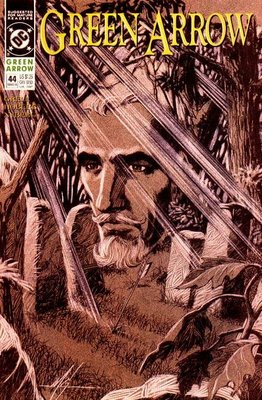 Another thing that shows the size of his balls is his " secret identity ". Which is virtually nonexistent. I mean, it´s not like anybody on the face of the earth can be fooled by the fact that Green Arrow and Oliver Queen have the same goatee, look like twins and just happen to live in the same city. Ollie just doesn´t cave. He´s like : " I´m not him. I am......somebody else. That´s my story and I´m going to stick to it. " though everybody knows he´s Green Arrow. I mean if you look at it all a hero with a secret identity CAN do is saying : " No, that´s not me. " and keep on denying it. Because if Oliver Queen really was Green Arrow wouldn´t he try to hide his features more when parading as a superhero ? Wouldn´t he wear more than a simple mask if it wasn´t just a one - in - a - million - coincidence that he just happens to look exactly like a certain bowslinging superhero ? So Oliver Queen has either the best or the worst secret identity ever. And he´s either the slyest bastard to roam god´s green earth or the most irreverent and carefree crimefighter. " Yeah, yeah, got your secret identity right here. Got myself a domino mask. Can we get on with the crime fighting ? " For all the shortcomings and squandered story possibilities the ONE redeeming quality of Green Arrow was his social awareness after he lost most of his fortune. Maybe that really was his superpower. Captain Mar - Vell was " cosmically aware " - Green Arrow was " socially aware " which let him stand out a little from the other heroes throwing around phrases like " capitalist fatcats " and " sticking it to the man " and such. That´s a big part of the success of the GREEN LANTERN / GREEN ARROW series by Denny O Neill and Neal Adams which cemented his character for all future generations. Like Hawkeye in the Avengers he´s always the one making trouble. Maybe it has something to do with archers always having a point.
Another thing that shows the size of his balls is his " secret identity ". Which is virtually nonexistent. I mean, it´s not like anybody on the face of the earth can be fooled by the fact that Green Arrow and Oliver Queen have the same goatee, look like twins and just happen to live in the same city. Ollie just doesn´t cave. He´s like : " I´m not him. I am......somebody else. That´s my story and I´m going to stick to it. " though everybody knows he´s Green Arrow. I mean if you look at it all a hero with a secret identity CAN do is saying : " No, that´s not me. " and keep on denying it. Because if Oliver Queen really was Green Arrow wouldn´t he try to hide his features more when parading as a superhero ? Wouldn´t he wear more than a simple mask if it wasn´t just a one - in - a - million - coincidence that he just happens to look exactly like a certain bowslinging superhero ? So Oliver Queen has either the best or the worst secret identity ever. And he´s either the slyest bastard to roam god´s green earth or the most irreverent and carefree crimefighter. " Yeah, yeah, got your secret identity right here. Got myself a domino mask. Can we get on with the crime fighting ? " For all the shortcomings and squandered story possibilities the ONE redeeming quality of Green Arrow was his social awareness after he lost most of his fortune. Maybe that really was his superpower. Captain Mar - Vell was " cosmically aware " - Green Arrow was " socially aware " which let him stand out a little from the other heroes throwing around phrases like " capitalist fatcats " and " sticking it to the man " and such. That´s a big part of the success of the GREEN LANTERN / GREEN ARROW series by Denny O Neill and Neal Adams which cemented his character for all future generations. Like Hawkeye in the Avengers he´s always the one making trouble. Maybe it has something to do with archers always having a point.The GREEN ARROW series written by Mike Grell with art by Ed Hannigan and various others started in 1987 and followed the hugely successfull GREEN ARROW LONGBOW HUNTERS three issue prestige format miniseries written and drawn by Mike Grell. If you are a Green Arrow fan you already know this comic and sing it´s praises on a daily basis. If you don´t know the comic.....stand up and get it RIGHT NOW ! What the hell are you doing reading the musings of this old comicgeek about two Green Arrow series when you still haven´t read the effing best Green Arrow story - EVER ? I mean how do you expect to set a standard for Green Arrow comics without the ultimate benchmark - the best there is, the best there was and the best there ever will be ? So stop reading my blog ( nooo, only for now !!! I need my three readers ! Come back ! ) go out and get LONGBOW HUNTERS. I´ll just wait....
 Okay. Now, wasn´t that just great ? Okay, back to topic. In the ongoing series Mike Grell was still writing but he was substituted by Ed Hannigan and a lot of others during the series. The approach to Green Arrow was a more realistic, urban kind of superhero which was influenced by the success of characters in the cinema at that time like Clint Eastwood in Dirty Harry or Charles Bronson in Death Wish. Costumewise the sleek costume with the hat and the long gloves was dumped in favor of a hooded and more functional costume. The design clearly was influenced by the Robin Hood mythology which is something every good comic writer should use when working on the character. It´s the one guy in world literature he has the closest ties to. And there are some issues where Mike Grell does it excellently.
Okay. Now, wasn´t that just great ? Okay, back to topic. In the ongoing series Mike Grell was still writing but he was substituted by Ed Hannigan and a lot of others during the series. The approach to Green Arrow was a more realistic, urban kind of superhero which was influenced by the success of characters in the cinema at that time like Clint Eastwood in Dirty Harry or Charles Bronson in Death Wish. Costumewise the sleek costume with the hat and the long gloves was dumped in favor of a hooded and more functional costume. The design clearly was influenced by the Robin Hood mythology which is something every good comic writer should use when working on the character. It´s the one guy in world literature he has the closest ties to. And there are some issues where Mike Grell does it excellently.In the beginning of the series Oliver and Dinah are still struggling with the fallout from Dinah´s torture and abuse ( not rape although that is what most readers instantly implied ) in LONGBOW HUNTERS. The fact that Dinah was tortured but not raped shows that the writer wanted to address the topic of violence against women without falling into the stereotype of rape. It IS one of the worst things that can happend to a woman but sadly it is not the only thing. So in order to deal with this problem they seek out a professional. And by that I don´t mean that they go on a spiritual walkabout with Jonn Jonnz or experience different possible futures via a psychomindreality machine or take up tantric sex lessions with Zatanna ( although that comic would have sold extremely well ! ). No, they do the reasonable thing and go to a psychatrist. Who as it turns out can identify with Dinah´s torment because a similar thing happened with her when she was a child. Turns out her attacker is about to be released from prison which turns into the first storyline about the differences of justice, vigilantism and the legal system. About where one thing ends and the next one starts, what are the uses and the flaws of them and what do you do when all of it just fails ? These things are recurring themes throughout the whole series and Oliver ( and other characters in the series ) has to deal with this issues constantly. He has to see different sides of him through Shado, the woman from LONGBOW HUNTERS, who is just like him in some aspects and very different in others or the assasin Eddie Fyres ( his name is spelled differently in a few occasions ) who crosses his paths a few times and is like a look through a black mirror showing what Oliver might turn into.
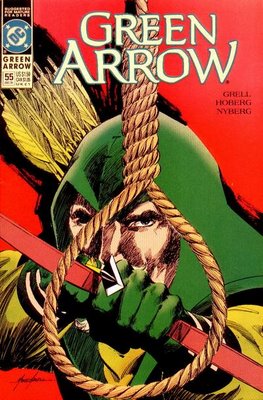 A lot of the characters throughout the series are morally ambiguous and very difficult to define as good or bad. Like the cop who faked evidence to put a killer behind bars only to find out that another killer was never caught who has been killing ever since. Or in the story where a rapist is released from prison and everyone knows he´s going to do it again but nobody knows what to do to prevent him from committing further crimes. This series is about the hard topics and the tough choices and there are a few instances where Green Arrow is forced to take a life to save others. And it´s not easy for the reader to judge his actions because you don´t really know what you would have done in his situation, what you would do in the real world.
A lot of the characters throughout the series are morally ambiguous and very difficult to define as good or bad. Like the cop who faked evidence to put a killer behind bars only to find out that another killer was never caught who has been killing ever since. Or in the story where a rapist is released from prison and everyone knows he´s going to do it again but nobody knows what to do to prevent him from committing further crimes. This series is about the hard topics and the tough choices and there are a few instances where Green Arrow is forced to take a life to save others. And it´s not easy for the reader to judge his actions because you don´t really know what you would have done in his situation, what you would do in the real world.Politics and social issues are a big part of this series. If you are one of the comic readers who think that comic books are just uncomplicated escapism and that they should not deal with real life than this is definitely the wrong book for you. Because the Oliver Queen in this series is entrenched in realism. He´s flawed, he makes mistakes and when he´s been in a fight he has the bruises to prove it. And he ages. One of the things I liked best about this series was the fact that Oliver ages through the course of the series. Not all superheroics are done by young, impressionable teenagers. Some are done by cynical old farts who know every dirty trick in the book. Ollie starts just before becoming 40 and by the last issues I´ve read he has passed the 50s. So the comic takes place almost in real time - many years before SAVAGE DRAGON or 24.
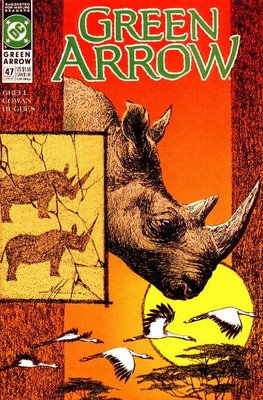 The topics that are explored in the series are terrorism ( like the IRA ), gay bashing, prison rape, AIDS, sexual assault and torture, poachers and the extinction of whole species for ivory, ecological disasters, corrupt government agencies, drug traffic, gang turf wars and the Yakuza - some of them too hot for todays comics. Being a " Suggested for Mature Readers " title the series doesn´t shy away from any topic or the graphic depiction thereof - without turning into exploitation. One of the big debates in the lettercolumns ( which help a great deal if there are gaps in your collection ) revolves about nudity and I have to say in the few instances I have seen it it was always done tastefully. You know it´s there to serve the story and not to give the reader a cheap thrill. No matter how much we may whish that more comic artists would go : " Screw that, I´m just going to draw 22 pages of naked booty. Because I can. " Or was that TAROT ?
The topics that are explored in the series are terrorism ( like the IRA ), gay bashing, prison rape, AIDS, sexual assault and torture, poachers and the extinction of whole species for ivory, ecological disasters, corrupt government agencies, drug traffic, gang turf wars and the Yakuza - some of them too hot for todays comics. Being a " Suggested for Mature Readers " title the series doesn´t shy away from any topic or the graphic depiction thereof - without turning into exploitation. One of the big debates in the lettercolumns ( which help a great deal if there are gaps in your collection ) revolves about nudity and I have to say in the few instances I have seen it it was always done tastefully. You know it´s there to serve the story and not to give the reader a cheap thrill. No matter how much we may whish that more comic artists would go : " Screw that, I´m just going to draw 22 pages of naked booty. Because I can. " Or was that TAROT ?Another big topic in the letter pages are the trick arrows and some writers make good arguments for them and others against them. Which shows why good letter pages add to comic series and it was just plain stupid when the big two decided to get rid of them. Because it just broadens the reading experience. You can read intelligent discussions about the topics that are presented in the comics, you can read different opinions or read how someone more eloquently brings your thoughts to paper. Or you can see things or points of the comic you missed.
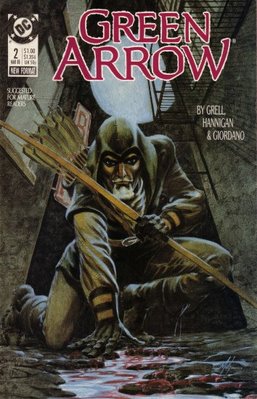 Now on the art side I have to say that I was not very happy to find out that Mike Grell was not doing the interiors ( though he does provide some terrific covers ). But the artists that do the art are all good artists in their own right and thankfully don´t try to copy Mike Grell. The artists are Ed Hannigan, Dan Jurgens, Denis Cowan and some others. Ed Hannigan in particular develops into quite the master storyteller in these pages. It is quite a shock to realize how much the storytelling is the center and the main focus of this series compared to nowadays. There are often long passages whithout words that give the story room to breathe. While Dan Jurgens´ art in the issues clearly shows the improvement he has made in human anatomy over the years it is also evident that his composition has become formulaic and less innovative in the later part of his career. Dennis Cowan was never a favorite of mine but his work in the pages of this pages looks like a cross between Klaus Janson and Scott Eaton, combining the best of two worlds. One of my favorite issues artwise is issue 8 by fill - in artist Paris Cullins who draws the second part of the story taking place in Alaska with a clean style that reminds me of the BATMAN ADVENTURES. Most stories are done in two issues with a few three- or four - parters which gives the stories more room to breathe. Instead of the approach comic writers take nowadays to stretch all stories out to six issues because than they can be sold better as a trade Mike Grell takes the necessary issues to tell the stories. No matter if that is one issue, two or four which makes for a great reading experience. And better than many books on the stands today. By far the best GREEN ARROW I have read.
Now on the art side I have to say that I was not very happy to find out that Mike Grell was not doing the interiors ( though he does provide some terrific covers ). But the artists that do the art are all good artists in their own right and thankfully don´t try to copy Mike Grell. The artists are Ed Hannigan, Dan Jurgens, Denis Cowan and some others. Ed Hannigan in particular develops into quite the master storyteller in these pages. It is quite a shock to realize how much the storytelling is the center and the main focus of this series compared to nowadays. There are often long passages whithout words that give the story room to breathe. While Dan Jurgens´ art in the issues clearly shows the improvement he has made in human anatomy over the years it is also evident that his composition has become formulaic and less innovative in the later part of his career. Dennis Cowan was never a favorite of mine but his work in the pages of this pages looks like a cross between Klaus Janson and Scott Eaton, combining the best of two worlds. One of my favorite issues artwise is issue 8 by fill - in artist Paris Cullins who draws the second part of the story taking place in Alaska with a clean style that reminds me of the BATMAN ADVENTURES. Most stories are done in two issues with a few three- or four - parters which gives the stories more room to breathe. Instead of the approach comic writers take nowadays to stretch all stories out to six issues because than they can be sold better as a trade Mike Grell takes the necessary issues to tell the stories. No matter if that is one issue, two or four which makes for a great reading experience. And better than many books on the stands today. By far the best GREEN ARROW I have read.If you want to read something more specific about the single issues and are not afraid of spoilers here are reviews of the first 12 issues from Jayme Lynn Blaschke´s Unofficial Green Arrow shrine
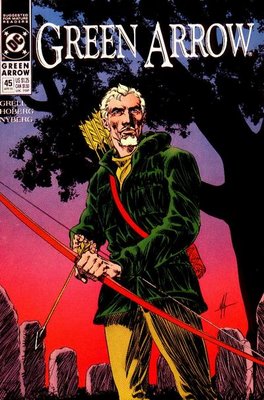 That´s all we have time for today. Tomorrow I will add some comments to this post or begin with part two.
That´s all we have time for today. Tomorrow I will add some comments to this post or begin with part two.New to the blog ? Everything you need to know about TALES FROM THE KRYPTONIAN :

It´s better to be pissed off than to be pissed on.

No comments:
Post a Comment